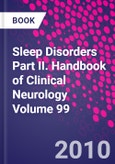Sleep Disorders II covers various aspects of sleep disorders. These include the different classification of sleep disorders, the genetic influences of sleep disorders, abnormality in the sleeping pattern, and the circadian rhythm sleep disorder. A sleep disorder is a medical disorder that affects the sleeping patterns of humans (and sometimes animals). The disruptions in sleep can be caused by different factors, such as teeth grinding, night terrors, and the like. The book also discusses different perspectives on insomnia and hypersomnia. According to the International Classification of Sleep Disorders, insomnia is a sleep that is low in quality or a difficulty in sleeping. On the other hand, hypersomnia is a sleeping disorder characterized by excessive daytime sleepiness (EDS) or prolonged nighttime sleep. The book discusses narcolepsy, a syndrome that is characterized by excessive daytime sleepiness that is associated with cataplexy and other REM sleep phenomena. The different medicines for this disease are also discussed. People who are practicing neurology and internal medicine, especially those in pulmonary, cardiovascular, gastrointestinal, renal and endocrine specialties, will find this book valuable.
Please Note: This is an On Demand product, delivery may take up to 11 working days after payment has been received.
Table of Contents
Section 1 History of sleep medicine 1. History of sleep medicine
Section 2 Basic science and methods 2. Normal sleep-recording and scoring techniques 3. Assessment of daytime sleepiness 4. Actigraphic monitoring of sleep and circadian rhythms 5. Video recordings and video polysomnography 6. Functional neuroimaging in sleep, sleep deprivation, and sleep disorders
Section 3 Basic mechanisms of sleep 7. The phylogeny of sleep 8. Ontogeny of EEG sleep from neonatal through infancy periods 9. Neurobiology of waking and sleeping 10. Neurobiology of REM sleep 11. Neurochemistry of sleep: an overview of animal experimental work 12. Molecular neurobiology of sleep 13. Manifestations and functional implications of sleep homeostasis 14. Thermoregulation in wakefulness and sleep in humans 15. Cytokines in immune function and sleep regulation 16. Endocrine and metabolic changes during sleep 17. Sleep, memory, and molecular neurobiology
Section 4 Clinical aspects of sleep disorders 18. Epidemiology of sleep disorders 19. Cardiovascular and cerebrovascular physiology in sleep 20. Cardiovascular diseases and sleep apnea 21. Alterations in gastrointestinal functioning during sleep 22. Sleep and genitourinary systems: physiology and disorders 23. Sleep enuresis 24. Respiratory physiology in sleep and wakefulness 25. Obstructive sleep apnea: diagnosis, risk factors, and pathophysiology 26. Upper-airway resistance syndrome 27. Central sleep apnea 28. Positive-pressure treatment of obstructive sleep apnea syndrome 29. Medical and surgical treatment of obstructive sleep apnea syndrome, including dental appliances 30. Noninvasive positive ventilation in the treatment of sleep-related breathing disorders 31. Sleep and pulmonary diseases 32. Sleep-associated respiratory disorders and their psychobehavioral consequences in children 33. Sudden death in infants during sleep 34. Neurobiology and the neurological basis of dreaming 35. Abnormal dreams and nightmare disorders 36. Sleep and psychiatric diseases 37. Sleep-related eating disorder 38. Alcohol, toxins, and medications as a cause of sleep dysfunction 39. Sleep, pain, fibromyalgia, and chronic fatigue syndrome 40. Women and sleep 41. Normal and abnormal sleep in the elderly
Section 5 Classification of sleep disorders 42. Classification of sleep disorders
Section 6 Genetics of sleep disorders 43. Genetics of sleep disorders
Section 7 Insomnia 44. Neurological perspectives in insomnia and hyperarousal syndromes 45. Insomnia: nature, diagnosis, and treatment 46. Pharmacotherapy for insomnia
Section 8 Hypersomnia 47. Hypothalamus, hypocretins/orexin, and vigilance control 48. Narcolepsy and cataplexy 49. Recurrent hypersomnias 50. Excessive daytime sleepiness
Section 9 Abnormal movements in sleep 51. Motor control in sleep 52. NREM parasomnias 53. REM sleep parasomnias 54. Isolated motor phenomena and symptoms of sleep 55. Sleep bruxism 56. Restless-legs syndrome and periodic leg movements in sleep
Section 10 Circadian rhythm sleep disorders 57. Molecular neurobiology of circadian rhythms 58. Circadian rhythm sleep disorders
Section 11 Sleep and neurological disorders 59. Fatal familial insomnia and the role of the thalamus in sleep regulation 60. Sleep disorders in Parkinson's disease 61. Sleep disorders in neurodegenerative diseases other than Parkinson's disease 62. Sleep and stroke 63. Sleep and headache 64. Sleep and breathing in neuromuscular disorders 65. Sleep-related epilepsy 66. Sleep disorders in multiple sclerosis
Section 12 Sleep and violence 67. Violent parasomnias: forensic implications








